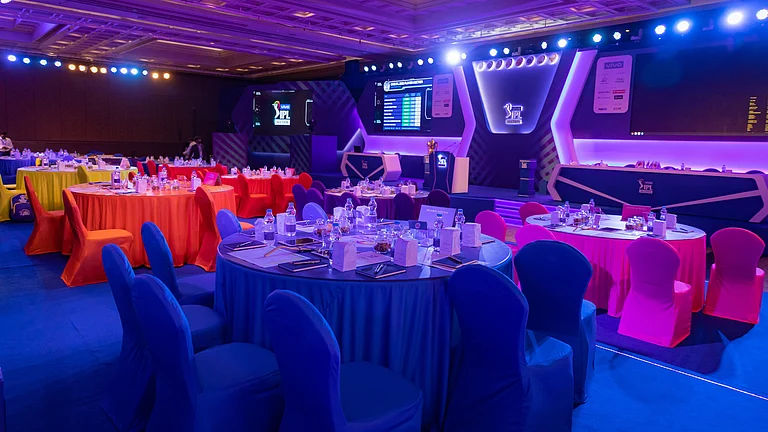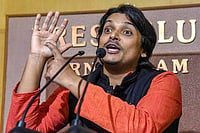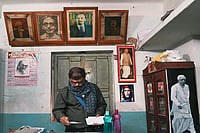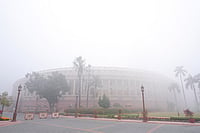***

The ultimate judge of public art, however, is the public. And those who cross paths with the installation have judged it puzzling and strange. Jaya Jaitly of Dastkari Haat Samiti, who passes by it every day, observes that for a work of "public" art, it doesn't have much to say to the public. "It's very out of place, considering the kind of people who frequent the spot—poorer people from the two hospitals, and lower middle-class Indians. It's too far-fetched, too sophisticated for a place like that."
Says Pooja Sood, curator of the country's first exhibition of Public Art installations currently on show at the capital, "You can't just put up something so radical without first building consensus. You have to make a concerted effort to engage the public who's going to live with it."
The capital is no stranger to ugly public art installations. In 2004, the Ministry of Home Affairs (with the backing of the DDA and NDMC) commissioned a particularly monstrous eyesore: the Police Memorial. A globe teetering on four 150 ft high steel columns, it was widely described as a "Rs 15-crore mistake", obstructing the view of Rashtrapati Bhavan from where it stood in Chanakyapuri. It took a Delhi Urban Arts Commission (DUAC) recommendation that it be demolished, and a suit at the Delhi High Court, to finally have it dismantled. Though the DUAC, formed in 1975, is supposed to represent the public's interest, Sprouts didn't get its clearance. "Normally, we'd have to be consulted," says DUAC head K. T. Ravindran. "It should have come to the commission."

Fibreglass pineapples at NT Rama Rao park, Hyderabad
Unlike abroad, where such projects are rewarded to designers or architects after competitions and the public's votes, in India the process is less than democratic. "Public art" often amounts to PWD-preferred art, as Hyderabad-based architect Shankar Narayan ruefully observes. "The problem is that the local administration doesn't involve urban designers, citizens or artists. They just get their bright ideas when they go abroad and duplicate them here without a thought to relevance, scale or size." And that's how, he says, the city got its disproportionate and popularly vandalised statues of small animals on traffic islands. Not to mention the "grotesque" outsized metal Charminar gateway leading to its hi-tech city's exhibition grounds.
Mumbai-based historian Sharada Dwivedi says the lack of checks and procedures also grants political parties unfettered access to public spaces. "We don't have any arts commission and our heritage committee is a toothless tiger, so what can you expect?" she says exasperatedly. "In the Dadar-Mahim-Shivaji Park area, the Shiv Sena have erected statues to reinforce Maharashtrian character—a woman in a nine-yard sari holding a puja thaal, a man resembling a dudhwala carrying a stick with two dabbas at the end of it. I've heard there's also a dabbawala somewhere there. I'm a Maharashtrian myself, but this is nonsense."
This is also why "beautification" drives conducted by local municipal corporations often result in what popular opinion finds hideous. Beside the splendid 'Triumph of Labour' statue on the Marina Beachfront in Chennai, for instance, is a plastic rock garden pile, which doubles up as an animated fountain and perch for plastic birds. "That's not public art," says critic Sadanand Menon, "that's public kitsch!"

Flame-thrower: A Dashrath Patel statue at the entrance of IT corridor in Chennai
This is also true of the ambitious—and significantly less ugly—Rs 1-crore public art project, along Chennai's IT corridor, in which the architectural firm hired by the Tamil Nadu Road Development Company (TNRDC) commissioned murals, statues and installations from artists and art students. Architect and critic A. Srivatsan observes, "Unlike pre-liberalisation era public art, centred on a political ideology, this is meant to stand for 'global city', to invite investors to form a favourable impression."
But aside from such "showpieces", many artworks in the public domain are treated with callousness and disrespect. Outstanding art like the 'Triumph of Labour' statue are caked with calcified bird-droppings. Worse, cases of vandalism—even by authorities—are rampant. Anjolie Ela Menon was mortified to find a painting hammered on to her six-panel mural at the Esplanade metro station in Calcutta—by the Metro authorities themselves. And sculptor Ratnabali Kant was aghast to find one of her statues in New Delhi's Garden of Five Senses hacked off at the ankles.
Bangalore-based sculptor Balan Nambiar, for his part, blames the lack of laws to protect public art. "My outdoor sculpture was mutilated and met with a custodial death in the hands of the traffic police, who bulldozed it," he says. "If there were a law protecting Indian public art, such a thing would never happen." He's hoping to improve things, though, by proposing to frame such a law with the Central Advisory Board for Culture. But what would really bring about a transformation, he says, would be for the wielders of power to visit a museum once in a while. "It's easy to get the place and money for public installations, but if decision-makers and administrators can't appreciate art, what's the guarantee that any of it will last?" Nambiar asks.


























